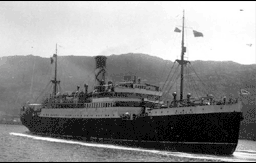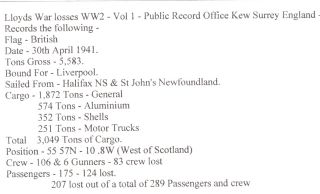Department Of National Defence Naval Service Report
REPORT BY SUB-LT. H.C. LEDSHAM, RCNVR
RE: SINKING OF SS NERISSA 30.4.41
H.M.C.S. “NIOBE” Stoke, Devonport, 19th May, 1941
Sir:
I have the honour to submit for your information a personal report on the sinking by enemy action of R.M.S. “NERISSA” on the night of the 30th of April, 1941.
The Naval Officers and ratings on board were as follows:
Pay. Cor. F.R.W. Nixon, R.C.N.
Lt. Cdr. Nicholl-Caddell, R.N. (Temp)
A/Sub. Lt. B. Harvey, R.C.N.
A/Sub. Lt. E.G. Robbins, R.C.N.
Pay. Sub. Lt. H.C. Ledsham, R.C.N.V.R.
Ord. Tel. W.H. Craig, R.C.N.
Ord. Tel. G.R. Craig, R.C.N.
Ord. Tel. R.K. McCrindle, R.C.N.
Ord. Tel. H.M. Lester, R.C.N.
Ord. Tel. J. Hutton, R.C.N.
Ord. Tel. R. Stinchcombe, R.C.N.
Ord. Tel. S.T. Kitching, R.C.N.
Ord. Tel. J.S. Newhouse, R.C.N.
Ord. Tel. C.J. Kent, R.C.N.
Ord. Tel. W. Coropka, R.C.N.
Ord. Tel. R.C. Bristow, R.C.N.
Ord. Tel. G.A. McKay, R.C.N.
Sub. Lieutenants Robbins, Harvey and myself had volunteered for lookout duties on the conning bridge and it was during my Watch that the sinking occurred. The night was exceptionally dark, the sky completely overhung and the horizon indistinguishable. There was a moderate sea and a slight wind. Previous to the time that the first torpedo struck there was no intimation that the enemy was near. An aircraft escort had left us at approximately 1830, reporting all clear.
At approximately 2234 we were struck by a torpedo on the starboard side, midway between lifeboats No’s three and five. The torpedo must have struck the engine room as the whistle, siren and electric bell were all rendered useless. The Captain of the Ship, G. Watson, detailed the extra Second Officer to proceed to the Wireless Room while he went to supervise the lowering of the lifeboats on the starboard side.
He detailed me, along with the extra Second Officer who had returned from the Wireless Room with the report that a message was going out on the auxiliary set, to lower the boats on the port side. The ship at this time was settling slowly and evenly. Within three minutes of the first torpedo, two additional torpedoes struck almost simultaneously, slightly abaft the first, on the starboard side, exploding the magazine containing ammunition for the Ship’s guns and no doubt claiming many lives.
At this point, the Ship broke in two and sank stern first in less than one minute. It is estimated that the time between the first torpedo and the complete disappearance of the Ship, was no more than four minutes.
I did not see Pay. Cdr. Nixon or Lt. Cdr. Nicholl-Caddell at any time after 1930 when they were seen dining together. They were detailed to number one lifeboat on the starboard side but none of the survivors with whom I talked had seen either of them. It is my opinion that they were lost.
I saw and spoke to the Sub. Lt. Robbins and Harvey at number two boat on the port side at which time they were aiding a Mr. and Mrs. Lomas with their three small children into number two boat. This had been done while I was lowering the guard rail. While the boat was being lowered, the second and third torpedoes struck creating general havoc among the passengers. It was observed that until this time the behavior of the passengers was exceptionally good.
As a result great numbers of people, presumably from the starboard side where Lifeboats No.’s three and five had been damaged by the explosions, rushed to the other available boats, resulting in the capsizing of all except No. seven which contained mostly members of the crew. In my opinion Sub Lieutenants Robbins and Harvey were either drowned or injured and subsequently died when they attempted to board No. two boat.
Seeing the large number of passengers making for the port boats, I proceeded for’ard with the hope of reaching some piece of loose wood or other buoyant object. The Ship, however sank before I reached the for’ard hatches and I was obliged to jump into the water. The bow of the Ship disappeared within five yards of my face and the sea was literally swarming with men. It was only after thirty to forty-five minutes of intensive swimming that I succeeded reaching a raft containing no more than five men. Together we succeeded in pulling others on board until with twenty men on board we drifted out of the area where the survivors were floating. Since the raft was upside down it could not be guided or propelled (Two paddles, one of which was later secured, were fastened to the upper side of the raft). One of this party died (presumably from exposure) during the night. The other nineteen plus sixty-five others in boats, capsized boats, rafts and wreckage were picked up by H.M.S. “VETERAN” at 0830 the following day and later transferred to H.M.S. “KINGCUP” who transported us to Londonderry.
I should like to mention, Sir, the wonderful treatment given to the survivors by the officers and men of H.M.S. “VETERAN”, H.M.S. “KINGCUP” and the Naval Staff at Londonderry.
Therefore to the best of my knowledge, and after conversations with many of the other survivors, it may be concluded that the only Naval survivors are myself and the following Telegraphists – Newhouse, Kent, Coropka, Bristow and McKay.
I have the honour to be, Sir,
Your Obedient Servant,
(signed) H.C. Ledsham
Pay. Sub Lieut. RCNVR.
The Commanding Officer
H.M.C.S. “NIOBE”
References:
Cr. Ref: MERCHANT SHIPPING N-Z; CASUALTIES PERSONNEL.
FILE: CD. 2-10; CD. 3-16.
NATIONAL DEFENCE, June 11, 1941.
Source: NS 1037-40-2V.12.
DECLASSIFIED – Authority: DHD 3-3; by ____ for DHist NDHQ; Date: May 15, 1990.


